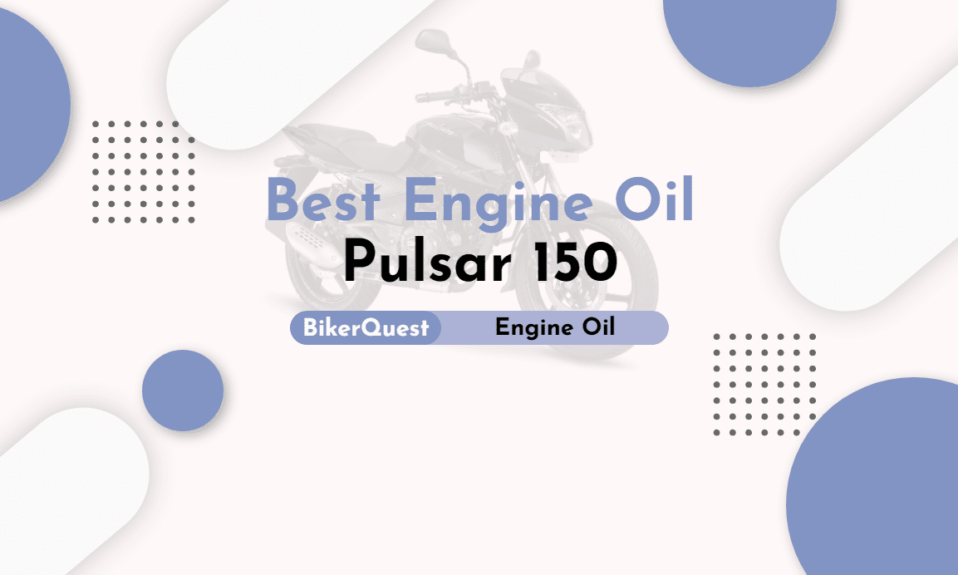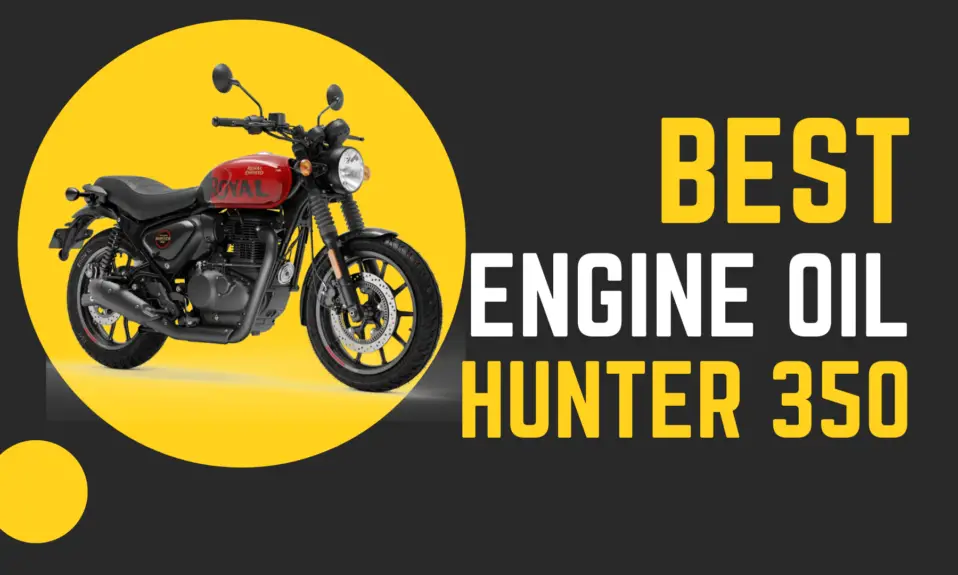As a proud owner of the Bajaj Pulsar 150, you know that maintaining your bike’s engine is crucial for optimal performance and durability.
One crucial aspect of maintenance is choosing the right oil for your engine. In this comprehensive guide, we shall take a look at the world of engine oils for Bajaj Pulsar 150 and cover everything you need to know in terms of basic concepts, frequently asked questions or expert advice on optimising your engine’s performance.
Before we get ahead let’s take a look at the best oils.
Table of Contents
Best Engine Oil for Pulsar 150 in a Glance
| Sl. No. | Name of Engine Oil | Type of Engine Oil | Click to Read Review |
| 1 | Castrol Power Ultimate | Fully-Synthetic Oil | Read Review |
| 2 | Motul 3100 | Semi-Synthetic Oil | Read Review |
| 3 | Castrol Activ Cruise | Conventional Mineral Oil | Read Review |
Understanding Engine Oil
A. Function of Engine Oil
The foundation of your Bajaj Pulsar 150’s engine is its oils, which are essential in providing crucial lubrication to the parts that move. It reduces friction and prevents wear and tear. In addition, it will help to cool the engine through the evaporation of thermal energy and contribute to maintaining a clean and performing engine by removing pollutants.
B. Different Types of Engine Oil
In motorcycles, there are different engine oil types, including conventional oils, synthetic oils and semisynthetic oils, also known as blended oils. Oil from crude oil is the source of conventional oils, whereas synthetic oils are artificially modified to provide superior performance and longevity. The semisynthetic oils balance out the two of them.
C. Key Properties of Engine Oil for Bajaj Pulsar 150
1. Viscosity
Viscosity is an indication of the thickness of engine oil at various temperatures. Each oil was given a viscosity grade by the Society of Automotive Engineers. The recommendation is to use SAE 20W-50 which shows its viscosity at lower and higher temperatures as Bajaj Pulsar 150.
2. API and JASO Specifications
Look for engine oils with API (American Petroleum Institute) specifications starting with SG or higher, as they meet the required standards for gasoline engines. JASO, a Japanese automotive standardisation organization, has separate ratings in the MA or MA2 category for wet clutch compatibility on motorcycles.
3. Synthetic vs. Conventional vs. Semi-Synthetic
Conventional Oils are suitable for standard usage while synthetic oils provide better performance and protection. Semi-synthetic oils are a good mixture of both. They are cost-effective options offering good performance at a much cheaper price tag than fully synthetic oils.
Choosing the Right Engine Oil
A. Manufacturer’s Recommendations
For the most recent engine oil recommendation please refer to your Bajaj Pulsar 150 owner’s manual. To ensure optimal engine performance and conformity with warranty, the following guidelines shall be followed.
B. Climate and Weather Considerations
Your geographical location and climate play an important role in selecting the correct engine oils. In colder regions, oils with lower viscosity, such as 10W-30, perform better during cold starts. The 20W-40 oils provide better protection against heat-related breakdowns in hotter climates.
C. Riding Conditions and Habits
Think about how you ride and your frequency. Synthetic oils can be preferable when you regularly ride long distances or take on harsh weather because they provide superior protection and stability in adverse conditions.
D. Mileage and Age of the Motorcycle
Try to use oils designed for older engines when your motorcycle is old or reaches a higher mileage. These oils are composed of additives that help the engine’s seals renew and reduce oil consumption.
Best Engine Oils for Pulsar 150
#1 Synthetic Option: Castrol Power Ultimate

Castrol Power Ultimate 1L
- Brand: Castrol
- Quantity: 1 L
- Viscosity Grade: 20w 50
- Oil Type: Fully Synthetic
- Drain Interval: 5000 km
This is the most prestigious and premium product from Castrol. One of the cheapest Fully Synthetic Oils, it can be used for about 5000 kilometres without any hassles. This oil provides best-in-class performance with its 5 in 1 formula.
The oil guarantees better acceleration, protection and a smoother riding experience. Castrol Power Ultimate is the best choice if your budget allows it. It provides a smoother experience and longer drain intervals.
#1 Semi-Synthetic Option: Motul 3100

Motul 3100 1L (20W-50)
- Brand: Motul
- Quantity: 1 L
- Viscosity Grade: 20w 50
- Oil Type: Semi-Synthetic
- Drain Interval: 3000 km
Motul 3100 is an entry-line Semi-Synthetic Oil from the house of Motul and offers the best value. It is budget-friendly and any Pulsar 150 user can easily afford to use it.
This can be used for around 3000 km and it is highly recommended to at least use this engine oil.
#1 Conventional Engine Oil: Castrol Activ Cruise

Castrol Activ Cruise 1L (20W-50)
- Brand: Castrol
- Quantity: 1 L
- Viscosity Grade: 20w 50
- Oil Type: Mineral with Synthetic Technology
- Drain Interval: 3000 km
Castrol Activ Cruise is a Budget Range Engine Oil from Castrol that now comes with Synthetic Technology that lasts longer than the other mineral oils on the market.
Castrol Activ Cruise comes with Actibond molecules that protect against the ill effects of long rides and fight harmful deposit build-up. Before buying it is suggested to check for the grade 20w 50 as the regular Castrol Activ comes with a Viscosity Grade of 20w 40.
FAQs about Engine Oil for Bajaj Pulsar 150
Synthetic vs. Conventional Engine Oil: Pros and Cons
A. Synthetic Engine Oil
1. Advantages
- Especially during extreme weather conditions, synthetic oils offer better protection.
- They’re designed to reduce engine wear and prolong the life of engines.
- They’re helping to improve fuel efficiency.
- They’ve got longer drain intervals, which means less oil change.
2. Disadvantages
- Synthetic oils are costlier than conventional oils.
B. Conventional Engine Oil
1. Advantages
- These oils are more affordable than the synthetic ones.
- They are widely and readily available in the market.
2. Disadvantages
- Provides lesser protection in extreme conditions.
- Frequent oil changes are required as they have less drain interval.
C. Making the Right Choice for Your Bajaj Pulsar 150
Your budget, riding conditions and how often you change oil will determine whether synthetic or conventional oils are chosen. Synthetic oils are the best choice when you seek top-quality protection and can afford a higher price.
Steps to Change Engine Oil in Bajaj Pulsar 150
Maintaining the engine health of your motorcycle requires a proper oil change. Follow these steps for a successful oil change:
A. Gather Necessary Tools and Materials
Check all the tools you need, like a wrench, oil filter tool, funnel and drain pan. Also, purchase the recommended engine oil.
B. Drain the Old Engine Oil
To drain the old oil, locate the drain plug, place the drain pan under it, and remove the plug. Hold on until all the oil’s gone.
D. Add New Engine Oil
Based upon the recommended quantity and type of engine oil in the user’s manual, fill up with new engine oil using a funnel.
F. Check the Oil Level
Let the motorcycle sit for a while, then use the dipstick to check the oil level after adding the new oil. If needed, adjust the level.
G. Dispose of the Old Oil Properly
Take the used oil to a recycling centre or an authorised oil collection facility, so that it may be safely disposed of.
Common Engine Oil-related Issues and How to Fix Them
A. Overfilling or Underfilling the Engine Oil
Overfilling or underfilling engine oil is one of the most frequent errors in an oil change. The excess filling may result in an increase in pressure and foaming, which could damage engine seals and gaskets. On the other hand, underfilling may result in insufficient lubrication, increasing wear and tear on engine components.
Always ensure an appropriate amount of engine oil is measured and filled according to the manufacturer’s instructions to avoid these problems. To ensure an accurate oil level, use the dipstick.
B. Oil Leaks and Seals
The common problem caused by damaged seals or gaskets is the leakage of oil. Always check the motorcycle for any signs of oil leakages, such as an oil stain at the bottom of your bike or seepage around its engine. If there are any leakages, they should be dealt with by a professional mechanic to avoid further damage to the engine.
C. Using the Wrong Type of Engine Oil
Your Bajaj Pulsar 150 engine may be damaged if you use the incorrect type of engine oil. In particular, poor engine performance and higher wear may result from the use of oil with a viscosity level that is not specified. Due to incompatible additives, non-motorcycle-specific oils may also lead to slippage in the clutch.
Choose engine oils with the correct viscosity and API/JASO specifications, always following the manufacturer’s recommendations.
D. Engine Oil Contamination
The accumulation of dirt, debris and engine residues can result in oil contamination over time. If not addressed immediately, contaminated oil will lose its ability to lubricate and may damage the engine. Keep engine oil regularly changed at recommended intervals to minimise the risk of oil contamination.
Maintaining Your Bajaj Pulsar 150’s Engine for Longevity
A. Regular Oil Changes and Maintenance Schedule
Adhering to a regular oil change schedule is crucial for the health of your Bajaj Pulsar 150’s engine. Follow the manufacturer’s recommended oil change intervals and avoid exceeding them, even if you’re using high-quality synthetic oils. Consistent maintenance ensures optimal engine performance and extends the life of vital engine components.
B. Other Important Fluids and Lubricants to Monitor
Aside from engine oil, your motorcycle relies on other fluids and lubricants for proper functioning. Regularly check and maintain the coolant, brake fluid, and transmission fluid, among others, to keep your motorcycle in top condition.
C. Signs of Engine Problems to Look Out For
Keep an eye on any signs of engine trouble as a responsible owner of a motorcycle. Underlying problems may be detected by unusual engine noise, reduced efficiency or excessive smoke in the exhaust system. To avoid further damage and expensive repair, these problems should be addressed without delay.
Expert Tips for Optimizing Engine Performance
A. Proper Warm-up and Cool Down Procedures
Before leaving for your journey, give your motorcycle’s engine plenty of time to warm up. During the warm-up process, avoid excessive engine revs. Likewise, to prevent possible damage due to sudden temperature changes, it is recommended that the engine be cooled before stopping.
B. Using Additives with Engine Oil
Although high-quality engine oil contains all the required additives, some riders may add other additives with special applications to improve fuel economy or engine cleanliness. Only additives that the motorcycle manufacturer or certified expert recommends are necessary to be used.
C. Monitoring Oil Consumption
Between oil changes, keep an eye on your motorcycle’s oil usage. The use of large quantities of oil could indicate engine problems, e.g. damaged piston rings or valve seals, which may require expert attention.
Conclusion
The most important decision affecting the performance, longevity and overall driving experience of your Bajaj Pulsar 150 is to choose the best engine oil. You can guarantee that your motorcycle engine will be in top shape for many years to come if you know the key characteristics of engine oil, comply with the manufacturer’s recommendations and perform regular maintenance.
For your riding conditions and habits, please ensure you choose the correct viscosity and API/JASO specifications. The Bajaj Pulsar 150 will run smoothly and efficiently, providing you with countless enjoyable road trips, whether you choose to opt for conventional, synthetic or semisynthetic oil, what is required is regular oil changes as well as good maintenance. Happy riding!






